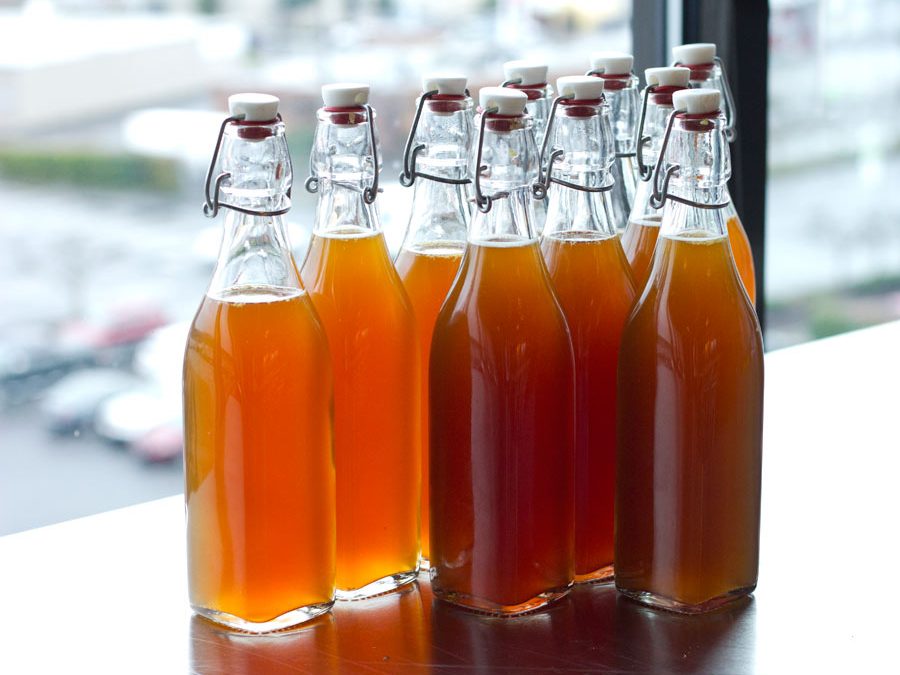Photography: Wren Bentley
I have been making Kombucha for almost 4 years and the reason I started were my kids. They were 4 and 2 years old and I gave them a bottle of Kombucha from the health food shop I started working at to see if they would like it. The drank the bottle in a flash and wanted more! I guess it was the flavour and the fizz, until then they only had water, herbal tea and milk to drink as we don’t buy soft drink or fruit juice. I was excited and decided to make my own. My friend gave me a SCOBY (Symbiotic Colony Of Bacteria and Yeast) and I learnt from a lady in America called Hannah Crum.
Since then the whole family has been drinking Kombucha and I must admit that my kids do have breaks from it. My husband tends to mix it with water on the weekends instead of having cordial like he used to and I have it daily with water and with my Psyllium Husk.
- Fermented tea, an ancient elixir consumed for thousands of years by civilizations all over the planet
- SCOBY – Symbiotic Colony of Bacteria and Yeast
- Originated in Asia
- The most definite recorded history of kombucha began in Ukraine and Russia during the late 19th century. Kombucha was very popular in Russia and Europe until World War II.
- In the 1960’s, Swiss research confirmed the health benefits of drinking kombucha, providing another boost to its popularity
- Over the last few decades, Kombucha has enjoyed a revival in Europe and has become popular in both Australia and the United States, especially since 2000. Although health scares occasionally occur, there is little or no direct evidence proving that Kombucha is the cause of any illness; more often sloppy brewing techniques or improper brewing vessels (i.e. lead, plastic, etc.) are to blame.
- The most commonly attributed Kombucha benefits include better digestion, increased energy, and a clearer mind
*Contains living bacteria and yeast
*Substituted for sugary sodas or multiple trips to the coffee pot
*Acts as a snack or pre-meal hunger control
*Alkalizes like vinegar or lemon juice – balances internal pH
*Compounds in the drink may bond to and help excrete toxins from the liver – happy liver = happy mood
*May speed metabolism
*The acids present may improve digestion or alleviate constipation
*Improved flexibility & fluidity of movement
*Smooth energy from low levels of tea
*May relieve headaches & migraines
*Antioxidants & polyphenols from the tea are partially fermented and so more bioavailable
Here is a recipe if you want to make your own and when you get your SCOBY make sure it’s fresh and hasn’t been sitting in the fridge.
Kombucha Recipe – 3.5l Continuous Brewing Method
Scale up or down depending on the size of your vessel
- 1 cup sugar
- 5 tsp loose tea
- Kombucha Starter Culture – SCOBY
- 1 cup starter liquid (Kombucha)
- water
- tea kettle
- glass juice dispenser with tap
- cloth cover
- rubber band
- two water jugs
—————————
- Boil 4 cups of water.
- Add hot water & tea to one jug
- Put your sugar into the other water jug
- Steep 5-7 minutes, then strain loose tea into jug with sugar
- Stir to dissolve, then cool down
- Fill juice dispenser with SCOBY, then add your cooled black tea and sugar mix, starter liquid and tap water, leaving just 1-2 inches from the top for breathing room with purified cold water.
- Cover with cloth cover and secure with rubber band.
- Set in a warm location out of direct sunlight
- Do not disturb for 7 days.
- After 7 days, or when you are ready to taste your KT, pour a bit out of your juice dispenser and taste. If too acidic, then reduce your brewing cycle next time. If too sweet, allow to brew for a few more days. Continue to taste every day or so until you reach your optimum flavour preference. It depends on how much sugar you have. I prefer my Kombucha Tea to be on the sour side.
- Decant into bottles making sure you leave 20% of your Kombucha in the juice dispenser.
- Do second ferment (flavouring).

